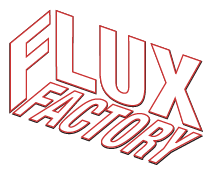Brooklyn Rail, November 2004


View of exhibition lounge at Flux Factory.
What The Book?
Flux Factory
November 2004
An embroidered scroll emanating from a fat papier-maché kitten, a pop-up dungeon diorama, phone books twisted and turned into spiral waves, a flipbook of armpits bound in dirty tee-shirt cotton. In What The Book?, over forty artists show works that explore the ideas and craft surrounding the book.
Entering the warm main space of the Flux Factory, there are multiple living room-like stations, complete with armchairs and coffee tables covered with small paper books. Not only does it look like one could settle into a full day of browsing, but people actually are. Some Fluxers sat with viewers and had long afternoon discussions. The topic under discussion (I could not help overhear) seemed to mirror the inclusive community of a library composed of smaller voices, in contrast to the normal authoritative hardcover breed.
This cultural thinktank atmosphere is something that the Flux Factory, a gem nestled in an industrial area of Queens, continues to foster in always unique and interesting ways. Past projects range from an edible art show to a Flux Factory member who offered walks home from Grand Central Station as an alternative to riding the subway. What The Book? continues the trajectory of these innovative projects by pushing the boundaries of display and expanding the conception of the art object.
Of the many books shown, John Meagher’s “Models for Installation” veers the farthest afield in format from the traditional. This mini storage box contains flattened rooms made out of balsam wood with flattened furniture that fits into the rooms like puzzle pieces. Each piece is inscribed with a sentence on the back, which seems to be an excerpt from a larger personal narrative. Though distant from a book in form, this piece shows how narrative can create a type of space, and how books can be seen as the containers of space.
Leaf Parsons and Elena Wen also explore the book as a form, in particularly, the way in which its form changes. In “Untitled,” a mass of negative space is revealed as you go through the book; it is literally cut out of the pages, grows in size as you turn the page.
One of the show’s highlights, “Making Stuff and Doing Things” by Kyle Bravo, is a plastic case containing a cassette tape and two small booklets. It lets the viewer experience two weeks of sights and sounds from the daily routine of Kyle Bravo. Each of the booklets chronicles two weeks of the artist’s life with a drawing of an object labeled with the time and date on each page. The author’s self absorbed obsessiveness is charming and ironic in this mock-therapeutic format.
Finally, Kerry Downey’s “Plans for Urban Outfitters” is a book of beautiful drawings where each page can be enjoyed on its own. The collection can be seen as an exploration of how time and sequence can affect works on paper like words in a poem.
-Sonya Shrier
